
Hoshigaki image from Wikipedia
Hoshigaki are a Japanese delicacy made by, believe it or not, gently massaging persimmons while they air dry. I took a workshop this weekend taught by Laurence Hauben on how to make this remarkable fall treat. It’s persimmon season right now, so if you want to try this at home you better jump on it. While a lot can go wrong in the month it takes to make Hoschigaki, the process is not complicated.
What kind of persimmons to use
The persimmons used to make Hoshigaki are astringent varieties such as Hachiya. Ideally, choose fruit that still has part of the stem. There is a workaround later in these instructions if you can’t find persimmons with stems. Use firm fruit, though a few soft spots are ok.
Slicing and peeling
The first step is to cut the top off, while carefully leaving the stem that they will hang from. Note the knife trick you use to do this. Turn the fruit, not the knife:

Next you peel the skin off the fruit:

Hanging
Cut a 24 inch length of string and tie it into a loop. Take two similarly sized fruit and tie their stems together with the string:

A 2 inch diameter bamboo pole is just about right to keep the persimmons separated.

A sunny window is a good place to hang the persimmons. The curtain, in the photo above, was only closed for the sake of the class. It’s best, actually, if the fruit gets sun. I’ve got mine hanging in our living room in a sunny window. And you want good air flow–either a fan or an open window (if it isn’t too cold out).
If the fruit does not have a stem attached you can insert a screw:

Drying
The first week you don’t touch them. After a week has passed you begin to gently massage each persimmon every other day. Hauben suggested a light touch rather than a “deep tissue massage.”
After a few weeks of massaging, fructose in the fruit will begin to come to the surface, making it look like the persimmons have been dipped in powdered sugar. They are done when they have a chewy texture.
In Japan, persimmons are dried by hanging them from the eaves of houses. A friend of mine who tried that had every single one consumed by squirrels in just one day. So indoors is the way to go.
Hauben’s class was really great–we went home with a crate of fruit and even our own bamboo pole. She teaches in the Santa Barbara area and you can find out more about her classes on her website: www.marketforays.com
For more detailed Hochigaki directions there is an Instructable.
I’ll report back in a few weeks on how our batch went.
Update:
Here’s a pic of our fruit after hanging inside for about a week. So far all looks good:

Update 2:
Mission Successful! They dried to perfection in one month. Read more here.
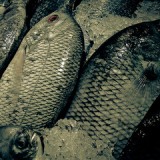
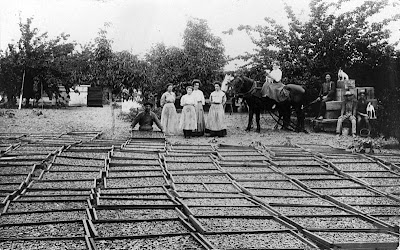
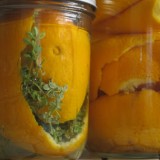
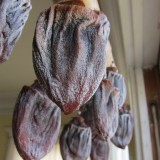
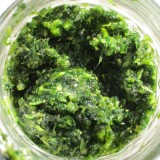
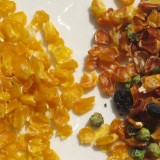
Yum! How the heck did someone originally ever think to ever come up with this tedious and time consuming process? Amazing.
Pingback: Reader: November 13, 2012 | updownacross
How do you keep insects off? It is mid-November here in Texas and we still have lots of bugs (yes they get inside the house too). I have been told by the agricultural extension that persimmons do well in our area though.
I’m working on my fifth season of hoshigaki in the Los Angeles area. Each year varies, because of weather conditions. This year is very hot and dry (only occasional rain or morning dampness)which makes for quicker drying. When the weather is damp, green mold forms in the creases. I’ve read that it can be removed with a damp toothbrush. I’ve tried this and it works.
About bugs, we have lots of flies (because we have chickens), but less at this time of year. I have not seen flies landing on the hoshigaki (right outside our windows and much observed). Fruit flies are not interested either, probably because the persimmon creates a new “skin” after its peeled. Also curiously, these have been impervious to bird and squirrel visitors, too.
I live where it is damp during persimmon season, so I use a dehydrator instead. I peel and slice the fruit into thick slabs, then dry them at 135 degrees F overnight. The persimmons do NOT have to be ripe (and it’s easiest to peel them when they’re hard), since they will ripen in the dehydrator. Even damaged or slightly green persimmons work well, and I have used Fuyu, Hachiya and some other unusual varieties also.
My father-in-law grows and dries his hachiya persimmons here in Orange County. He likes to peel them one long strip which he dries also. I’ve seen this done in Japan and the dried peels pickled in rice bran or as my F-i-L does chiffonades the dried peels and adds them to sunomono(vinegar salad).
My husband is trying to dry and make Hoshigaki for his first time. Today is the 4th day but we notice a little mold all over them. Can someone tell us what is causing this. He threw his 1st batch away because they became so moldy,
Thanks. . . Marilyn [email protected]
Hi Marilyn–mold can be a problem. You can prevent it by increasing heat and air flow. The more sun they get the better–hanging them in a sunny window is what we did. You can also put a fan on them to increase air flow. And as they dry you want to try to gently massage out the creases to prevent mold growth later on in the process.
i struggled with mold the first year but found on line the suggestion to dip the peeled fruit in boiling water first (i do it after tying them on the strings) and it really does the trick.
Pingback: Hoshigaki Success! | Root Simple
A Japanese friend of mine just sent me a care package. In it were several boxes of dried persimmons. They are incredibly sweet and tasty. I ate four of them though I wish I had eaten just one. Will savor the remaining persimmons. As far as I am concerned, they are better than fresh off the tree.
Had to laugh when you mentioned the squirrel eating all of the persimmons. We have two pecan trees in our backyard. All but the first year when we were able to harvest a hand-full the squirrels have been eating the nuts while still green while all we get are half-eaten green pecans. Those that make it through the riping process will be devoured by the squirrels.
Back to the persimmons. I thoroughly enjoyed your article. My Japanese friend sent me a picture of persimmons drying outside houses in Japan. Suppose they don’t have hungry squirrels?
This puzzles me too–the drying outside thing. I’m wondering if they’ve developed some trick that we don’t know about, something in the way they are hung up. (Or maybe they just have sharpshooters on patrol!) Here, if the squirrels didn’t get them, the roof rats, raccoons or possums would.
They sure look pretty hanging outside, though.
A long time ago, Japan sought out to get rid of the squirrel. So, with the exception of a few places on Honshu. There are no squirrels in Japan. One of the Japanese women I teach English to, says that after you peel the persimmon, you quickly dunk each one in boiling water. No longer than 20 seconds, just to create a barrier for when you hang it outside.
Anyone else, hear this theory?
I just finished drying my first batch and they’re awesome. I did dunk them in lightly boiling water for about 10 seconds before hanging. They were hung outside on the sunny side of the house and under the roof line to protect from rain (what little we’ve had). No problems with bugs, birds, or squirrels and no problems with mold. We’ll definitely do lots more next year. Yummy!
Pingback: Darf ich vorstellen_Gotgam | missboulette
I have a mold problem, so I switched to a window and used a fan
on low setting, now several of my persimmons have seperated from their stems and have fallen off. Any suggestions? I’m super sad because I am losing so many.
No doubt about it hoshigaki can be tricky. A sunny window is important. Air flow should help. You can use a screw as a substitute for the stems if they are missing.
Pingback: 5 Ways to Use Persimmons (Not Just Recipes) | Gantz Family Vineyards
I made hoshigaki from firm and ripe persimmons and hands down the overripe ones were the best. I dried mime inside and outside. After three months of constant sun and the fruit almost black I took them down and stored them in mason jars. I could not stop eating them, the few left eventually got the white sugar coating on them. Can’t wait for next year!
Pingback: A Winter Treat | Imbibe Korea
Pingback: How To Make Hoskigaki (Dried Persimmons) — Homestead and Survival
Pingback: How to Make Hoshigaki | Health & Food - Popular Question & Answer
Pingback: ruff linkage 201348
Hello,
I like dried persimmons.
It is easier to hang them if the stem at their bottom is left as a letter T with part of the tree twig at the top. You just put that T part into between the strands of a plastic rope.
But persimmons sold at stores do not have the stem in that way, so you need to tie the stem with string.
This was Super helpful in my venture into Hoshigaki Persimmons. One thing I did differently was dipping my Hachiyas in vodka before hanging. Helps with mold. Check out my blog:
http://www.christianreynoso.com/mealsforme/2014/11/11/hoshigaki-persimmons
How do I get rid of gnats on my hochigaki?
Did you use astringent persimmons(in Japan:shibu-gaki 渋柿)?
If you can eat persimmon at raw, the persimmon is not an astrigent persimmon.It is a sweet persimmon(in Japan:ama-gaki 甘柿)
Yes, I used astringent persimmons.
Are the persimmons still edible if they have a little mold left on them as they dry. I can’t seem to eliminate the mold totally, even with all the suggestions listed.